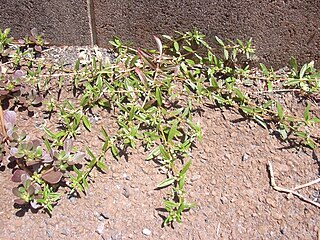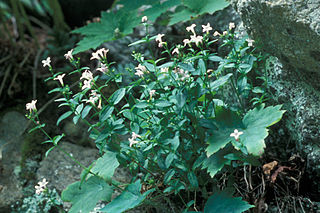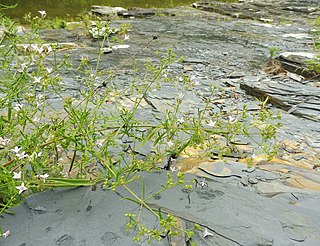
Oldenlandiopsis (creeping-bluet) is a genus of flowering plants in the family Rubiaceae. It is monospecific, comprising only one species, Oldenlandiopsis callitrichoides. This species had previously been placed in Hedyotis or in Oldenlandia. It is native to the West Indies, southern Mexico, and Central America. It is naturalized elsewhere, including Florida, Hawaii, South America, and tropical Africa.

Houstonia (bluet) is a genus of plants in the family Rubiaceae. Many species were formerly classified, along with other genera since segregated elsewhere, in a more inclusive genus Hedyotis.

Oldenlandia is a genus of flowering plants in the family Rubiaceae. It is pantropical in distribution and has about 240 species. The type species for the genus is Oldenlandia corymbosa.

Bridelia micrantha, the mitzeeri or the coastal golden-leaf, is a tree in the family Phyllanthaceae and is native to tropical and southern Africa as well as to the island of Réunion in the Indian Ocean.
Hedyotis (starviolet) is a genus of flowering plants in the family Rubiaceae. Many species of this genus such as Hedyotis biflora, H. corymbosa and H. diffusa are well known medicinal plants. Hedyotis is native to tropical and subtropical Asia and to islands of the northwest Pacific. It comprises about 115 species. The type species for the genus is Hedyotis fruticosa.

Kadua is a genus of flowering plants in the family Rubiaceae. It comprises 29 species, all restricted to Polynesia. Twenty-two of these are endemic to the Hawaiian Islands. Some of the species are common at high elevation. Others are single-island endemics or very rare, and a few are probably extinct. Kadua affinis is widely distributed in Hawaii and is polymorphic. The type species for the genus is Kadua acuminata.

Houstonia purpurea is a species of flowering plant in the coffee family known by the common names Venus's pride, woodland bluet, and purple bluet. It is native to the eastern United States from eastern Texas and Oklahoma east to Florida and Pennsylvania, with scattered populations in Nebraska, Iowa, Michigan, New York State and New England.

Trema micranthum, the Jamaican nettletree or capulin, is a plant species native to warmer parts of the Western Hemisphere. It has been reported from Mexico, Central America, tropical South America, the Virgin Islands, Jamaica, Cuba, Hispaniola, Puerto Rico, and southern Florida.
Houstonia ouachitana, the Ouachita bluet, is a species of plants in the coffee family. It is endemic to the Ouachita Mountains of Arkansas and Oklahoma. It is an herb up to 20 cm tall, with lanceloate basal leaves and narrowly linear cauline leaves.
Houstonia croftiae, the South Texas bluet or Croft's bluet, is a species of plants in the family Rubiaceae. It is known only from 9 counties in southern Texas: Hidalgo, Starr, Zapata, Webb, La Salle, Duval, Jim Wells, Refugio and San Patricio).

Houstonia correllii, the Zapata County bluet, or Correll's bluet, is a species of plants in the Rubiaceae. It is known only from Zapata County in southern Texas. It is a prostrate, mat-forming plant with white flowers.
Houstonia acerosa, the New Mexico bluet or needleleaf bluet, is a plant species native to Chihuahua, Coahuila, Nuevo León, Tamaulipas, San Luis Potosí, Texas and New Mexico.
Houstonia palmeri, the Saltillo bluet, is a plant species in the family Rubiaceae, native to the Mexican states of Coahuila and Nuevo León.
Houstonia parviflora, the few-flowered bluet or Greenman's bluet, is a plant species in the Rubiaceae, found only in south-central Texas.
Houstonia rosea, the rose bluet, is a North American plant species in the coffee family. It is a tiny plant only a few centimeters tall, with pink flowers. It is native to the south-central United States: Texas, Oklahoma, Arkansas, Louisiana, Mississippi, Alabama and southern Missouri.
Houstonia sharpii, the Hidalgo bluet, is a plant species in the family Rubiaceae. It is a herbaceous perennial up to 30 cm tall, spreading by means of stolons spreading along the surface of the ground. It also has white flowers. It is native to the states of Hidalgo, Puebla and Veracruz in Mexico.
Houstonia spellenbergii is a plant species in the family Rubiaceae. It is native to the western part of the state of Chihuahua in northern Mexico, at an elevation of approximately 2100 m in the Sierra Madre Occidental near the Basaseáchic waterfall.
Houstonia subviscosa, the nodding bluet, is a plant species in the Rubiaceae. It is native to Texas.

Spermacoceae is a tribe of flowering plants in the family Rubiaceae and contains about 1346 species in 57 genera. Its representatives are found in the tropics and subtropics.

Stenaria is a genus of flowering plants in the family Rubiaceae. It is a small genus, consisting of around six species native to the United States, Mexico, and The Bahamas. All species of Stenaria are restricted to Mexico and the southwestern United States, except for the wide-ranging Stenaria nigricans which extends northward and eastward.










